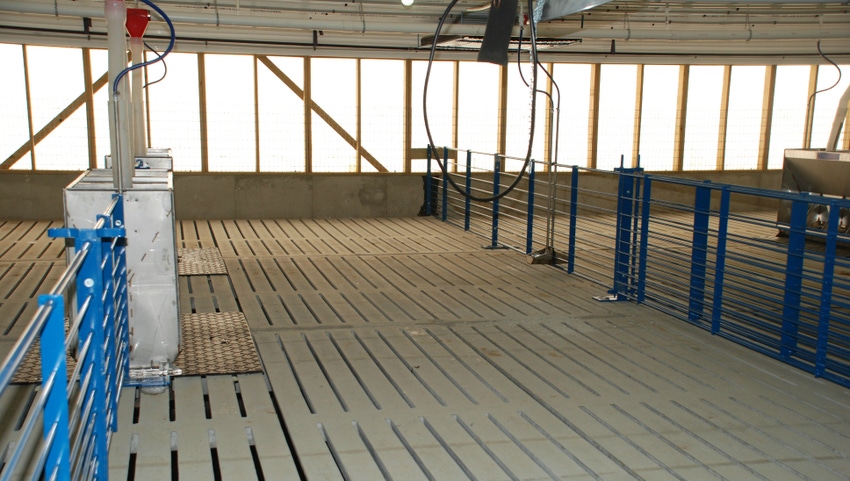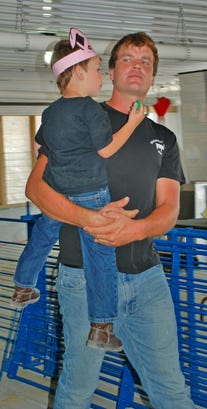Production partnerships give young producers an opportunity to return to the family farm full time.

On Aug. 17, Alex Winkelman and his family will unload the first batch of pigs in a new finishing barn near Concord, Ill. This is the third wean-to-finish facility in the Winkelman family. Alex’s dad, Dale, says bringing hogs into the family farming operation is the best way to allow both his sons, Adam and Alex, to return to the farm after college.

Alex Winkelman is embarking on new real pig farming adventure in order to return to the farm full-time
Alex was looking for a way to expand his personal farming operation of crops and cattle. Winkelman says the competition and the capital expenditure needed for row crops is a big obstacle for beginning farmers. So to be able to hang up his keys to a fleet of trucks to enter farming full time, he embarked on a new pig farming adventure as a production partnership with The Maschhoffs. “It is a good investment. Corn is cheap and land is high. There is not a lot of opportunity to expand in row crops,” he says.
For Winkelman, a production partnership is the right fit with many benefits and minimizing risk is the top advantage. As a high schooler, Winkelman and his brother finished hogs outside year around. He firmly admits that he will not return to that production model. “There were times you made money and there were times you lost everything you made,” he says as he heartily chuckles.
Farming full time for this fifth-generation farmer or financing a hog facility to this magnitude would not be possible without taking advantage of this contract production opportunity. Frankly, Winkelman says, “it would be hard to get a bank to lend me money to build this type of building and raise hogs independently, especially as a young producer.”
Production partnerships spread the risk across all parties involved. Essentially, the pig farmer provides the building, labor and certain record-keeping functions whereas the company supplies the pigs, feed, animal health inputs, experts and handles all marketing responsibilities.
Hauling hogs for The Maschhoffs for more than 10 years, Winkelman was already familiar with the company and its solid reputation. The availability of experts from veterinarians to nutritionists to environmental engineers is valuable. Moreover, as evident at the open house held on Aug. 4, the comradery offered by The Maschhoffs’ team is priceless.
Diversifying the farm by adding pork production also adds a significant value by supplying organic nutrients for the cropland. Utilizing nutrient management plans, the Winkelman family uses the manure generated from pigs to provide necessary nutrients for growing row crops, replacing commercial fertilizer. “The manure is a huge part of it. We have seen up to 20 bushels per acre increases in yields. It makes my operation more profitable and even make a profit in some years,” says Winkelman.
Nutrient management plans are not only a requirement for larger hog farms but also a welcome management tool for farmers. (This barn is not large enough to require a nutrient management plan. However the family is working with The Maschhoffs to develop one.) Winkelman appreciates the access to top-notch professionals available at The Maschhoffs to help him properly manage manure, fine-tuning the plan for soil type and the crop being raised.
Walking the barn, the Winkelmans took full advantage of the latest technology to protect pigs, people and planet. As typical in new construction, the site has no lagoon but 8-foot pits under the new slatted floors. A positive pressure ventilation system was installed with all environmental aspects easily controlled virtually any time of day.
Building a new livestock facility is not as simple as erecting the structure. Individuals, like the Winkelman family, must go through a process before breaking ground on a new structure. Nic Anderson, livestock business developer for the Illinois Livestock Development Group, explains, “Illinois has the Livestock Management Facilities Act – a uniform set of standards across the state governed by the Illinois Department of Agriculture. So when famers are looking at livestock, especially like the Winkelmans did on a hog barn, there is a process really before they apply for a permit. Farmers need to ask do I have site available, what are the rules or qualifications and then you go seek out who I can go work with.”
One of the first steps in the permitting process under the LMFA is finding your site and then filing a notice of intent with the IDA. The farmers must include information such as the site location, the size of the facility, the building design and set-backs. The clock starts ticking at the time the notice of intent is filed. In 30 days, the government agency will verify all the information including on-site inspection with all environmental impacts assessments. In addition, the IDA will inspect during the construction process and again before any animals can be placed in the facility.

The Winkelman family hosts an open house to educate the public about pork production
Anderson says communicating with neighbors and the community is an essential part of the process. It is always to be open with the plans of a new livestock facility. Public hearings are only required for units larger than 1,000 animal units, which translates to 2,500 pigs at 55 pounds or larger. However, a county board or 75 registered voters can request a public hearing. For the Winkelman family’s new barn, a hearing was not necessary.
In fact, Anderson says on average 100 to 150 permits are filed in a year and typically only four public hearings are held. Moreover, Anderson says the good part about Illinois’ standards is the consistent process. Anderson says, “The public hearing process is there to inform the public about the buildings and how they meet the requirements. Unfortunately, sometimes it tends to turn into in something other than education.”
The main role of the ILDG is to lend support, embrace for the criticism and be a resource for livestock producers. Six organizations, including pork, beef, milk, farm bureau, corn and soybean associations, formed ILDG and pooled their resources to develop a long-term producer-driven strategy to restore profitability to the state’s livestock industry.
Hosting an open house is also a good way to show pork production to the public. Visitors can walk the barn before pigs are moved into the building and first-hand to see the facility, the new equipment and the entire infrastructure in place to address environmental issues.
“The open house is to educate the public. We want them to ask the questions about pork production,” Anderson says. “We want them to go to their families and friends and tell them about pork production and these long white barns are nothing to be afraid of.”
About the Author(s)
You May Also Like



